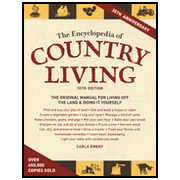We have a little checklist we go through each summer to ensure we're ready when hurricane season rolls around, you know, batteries, flashlights, water, gasoline, lamp oil, candles, ice, etc. As far as food is concerned, we have a freezer full of chickens that we raise once a year and butcher. The problem with that is electricity. If the power goes out for any length of time, we'll have to shift about 50 cut up chickens to ice chests as well as begin eating BBQ chicken for breakfast, lunch and supper to avoid spoilage!
For weather emergencies or just good preparedness, it is a good idea to have a well-stocked pantry. As you can see our potato harvest from back in mid-May is almost depleted. We like the new red potatoes (crawfish potatoes, some people call them). We dig them up in May and hang them in an onion sack from a tree for a couple of days to let them cure. That allows them to dry before putting them in a cool, dark place (the pantry) for a while. They have lasted over 3 months with little to no spoilage and we eat a lot of potatoes.
 |
| The bottom of the barrel. |
 |
| Everything tastes better in a cast iron skillet! |
Back to the pantry: I have read that Mormons keep a year's supply of food stored to ensure that they can take care of themselves, their families and their neighbors in case of an emergency. That sounds like good advice. It seems overwhelming to have that much food, but from what I read they do it a little at a time, buying (or canning) a few cans here, a few cans there, and before you know it, you have a storehouse. We mainly can food to preserve the harvest. We try to grow more than we can eat. Then we eat as much as we can fresh. For the amount of fresh fruits and vegetables we can't eat fresh, we blanch and freeze. Blanching is when you plunge fresh vegetables under boiling water for a brief period of time and then remove and put immediately under ice water to stop the cooking process. Then you freeze in serving size containers. Once you thaw and cook, it is very close to tasting like fresh picked produce. The items we don't eat fresh and we don't blanch and freeze, we can. In the picture above, you can see sliced carrots, beets, corn, jalapenos, cucumbers, pickled okra, pickled green beans, pickled beets, pickles, fig preserves, blackberry jelly and muscadine jelly.
 |
| Pints of local honey |
If you're interested in getting started with canning foods or learning about anything to do with homesteading, a good reference we've found is a book by Carla Emery called The Encyclopedia of Country Living.
Here are just a few of the things you'll learn to do in this helpful reference manual:
- Find and buy your plot of land
- Site and build your house or cabin
- Create a vegetable garden
- Log your land
- Manage a herd of cattle
- Raise chickens, goats, and pigs
- Mill your own flour
- Bake your own bread
- Sharpen an axe and all your knives
- Prune a tree
- Can, dry and preserve food
- Learn basic beekeeping
- Light your table with candles you made
Why, who knows, you learn all that and you may move out to Walnut Grove with Charles Ingalls and his family!
We'll be battening down the hatches tomorrow afternoon at our little house on the prairie in preparation for Isaac. We'll keep you posted. Stay safe (and prepared!)



No comments:
Post a Comment